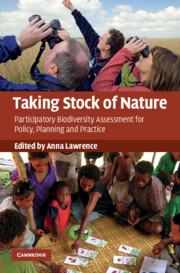Book contents
- Frontmatter
- Contents
- List of contributors
- Acknowledgements
- 1 Introduction: learning from experiences of participatory biodiversity assessment
- 2 Monitoring and assessment of biodiversity under the Convention on Biological Diversity and other international agreements
- 3 The Millennium Ecosystem Assessment: a multi-scale assessment for global stakeholders
- 4 Conservation of biological diversity in El Salvador shade coffee: the importance of taxonomic capacity for participatory assessments
- 5 Taking stock of nature in species-rich but economically poor areas: an emerging discipline of locally based monitoring
- 6 Researching local perspectives on biodiversity in tropical landscapes: lessons from ten case studies
- 7 Participatory resources monitoring in SW China: lessons after five years
- 8 Forest inventory in Nepal – technical power or social empowerment?
- 9 Perceptions of landscape change in British Columbia's Northwest: implications for biodiversity and participatory management
- 10 How thousands planned for a billion: lessons from India on decentralized, participatory planning
- 11 Inside monitoring: a comparison of bird monitoring groups in Slovenia and the United Kingdom
- 12 The personal and political of volunteers' data: towards a national biodiversity database for the UK
- 13 Improving forest management through participatory monitoring: a comparative case study of four community-based forestry organizations in the Western United States
- Index
- References
2 - Monitoring and assessment of biodiversity under the Convention on Biological Diversity and other international agreements
Published online by Cambridge University Press: 06 December 2010
- Frontmatter
- Contents
- List of contributors
- Acknowledgements
- 1 Introduction: learning from experiences of participatory biodiversity assessment
- 2 Monitoring and assessment of biodiversity under the Convention on Biological Diversity and other international agreements
- 3 The Millennium Ecosystem Assessment: a multi-scale assessment for global stakeholders
- 4 Conservation of biological diversity in El Salvador shade coffee: the importance of taxonomic capacity for participatory assessments
- 5 Taking stock of nature in species-rich but economically poor areas: an emerging discipline of locally based monitoring
- 6 Researching local perspectives on biodiversity in tropical landscapes: lessons from ten case studies
- 7 Participatory resources monitoring in SW China: lessons after five years
- 8 Forest inventory in Nepal – technical power or social empowerment?
- 9 Perceptions of landscape change in British Columbia's Northwest: implications for biodiversity and participatory management
- 10 How thousands planned for a billion: lessons from India on decentralized, participatory planning
- 11 Inside monitoring: a comparison of bird monitoring groups in Slovenia and the United Kingdom
- 12 The personal and political of volunteers' data: towards a national biodiversity database for the UK
- 13 Improving forest management through participatory monitoring: a comparative case study of four community-based forestry organizations in the Western United States
- Index
- References
Summary
Introduction
The central instrument in international efforts to conserve and sustainably use biodiversity is the Convention on Biological Diversity (CBD), which was opened for signature at the United Nations Conference on Environment and Development (UNCED) in Rio de Janeiro in 1992 and entered into force in December 1993. The Convention was adopted against the background of an existing web of other global biodiversity-related treaties. These include: the 1971 Ramsar Convention on Wetlands of International Importance; the 1973 Convention on Trade on Endangered Species of Wild Fauna and Flora (CITES); the 1979 Bonn Convention on Migratory Species and specific ‘range state’ instruments adopted under its auspices; and the 1972 World Heritage Convention. (Websites for these conventions are listed at the end of the references section of this chapter.) These are supplemented by numerous regional agreements, addressing the conservation and sustainable use of terrestrial and/or marine biological diversity.
The existence of biodiversity-related international agreements reflects a wider move towards treaty-based global environmental governance. The number of multilateral environmental agreements (MEAs) has increased significantly in the period since the 1970s as the international community has recognized the interconnectedness of global environmental threats (Sands, 2003, p. 127; Desai, 2004, p. 106). Global conferences, such as the UN Conference on the Human Environment in Stockholm in 1972 and UNCED, have often provided the impetus for the negotiation and conclusion of new MEAs.
- Type
- Chapter
- Information
- Taking Stock of NatureParticipatory Biodiversity Assessment for Policy, Planning and Practice, pp. 30 - 48Publisher: Cambridge University PressPrint publication year: 2010
References
- 1
- Cited by

